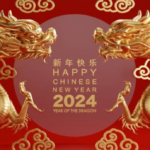Christmas in Spain: A Festive Blend of Tradition and Joy – Nora DP
Christmas in Spain is a time of the year full of joy, happiness and kindness. From the beginning of December until the 6th of January the streets turn into luminous and decorated promenades where children could spend hours just admiring the decorations. There are also a lot of markets all over the big cities such as Madrid, where people go to have hot chocolate and churros, watch the lights and buy some new decorations for their houses.
Christmas market in Plaza Mayor, Madrid.
In addition to the decorations, the moment when people realize that a new season is approaching is when it’s time to buy the Christmas lottery, known as “El Gordo.” This event takes place on December 22nd, and every house turns on their televisions to listen to two children singing the winning numbers.
The next important date is Christmas Eve, on December 24th. On this night, families and friends gather for dinner. These dinners typically include traditional dishes such as seafood, lamb, or ham, along with Spanish sweets like ‘turrón’, ‘polvorones’, or marzipan (‘Mazapan’ in Spanish). After having dinner all together, families usually play games, sing Christmas carols or if they are religious, they attend a midnight Mass to commemorate the birth of Jesus, which is more popular in small towns or communities. That same night, all the children go to bed feeling nervous, thinking and dreaming all night about what Santa Claus (Papa Noel) will bring them as soon as he comes down the chimney.
The next morning, the 25th of December, Families spend the morning opening and enjoying gifts found under the tree. Then, they usually prepare and share meals with their loved ones, enjoying the day all together.
New Year’s Eve, celebrated on the 31st, marks the end of the year. In Spain we have a tradition where we eat 12 grapes with the rhythm of the midnight bells, one per month, as a symbol of good luck. This tradition is practiced both in family gatherings with the news on for the bells, and in large public celebrations, where music and fireworks mark the arrival of the New Year. In Madrid, for example, Puerta del Sol is filled with people because it is where the big clock tower is located, guiding the entire city.
The Christmas festivities end with the arrival of the Three Wise Men on January 6th. On the evening of January 5th, cities host parades where the Three Wise Men travel through the streets, throwing candies and greeting children. During the night, the Wise Men leave gifts in people’s homes. In many homes, before going to bed, cookies or some sweets are left out, along with carrots and water for their horses. Epiphany is also a time to enjoy the ‘Roscon de Reyes’ a sweet pastry filled with a hidden figurine and a bean. If you find the figurine, you get a bit of joy, but if you find the bean, you have to pay for the ‘Roscon’.
But also in Spain, there are some regions that add their own touch, celebrating Christmas in its own way. In Catalonia, the Caga Tió, a log that “poops” gifts when children hit it, is very popular. In the Basque Country and Navarre, Olentzero, a kind charcoal maker, delivers the presents (instead of having Santa Claus)
So, we can say that Christmas in Spain is a magical time filled with fun traditions, delicious food, and special moments with family and friends. From beautiful lights and markets to unique customs like eating grapes on New Year’s Eve or celebrating with the Three Wise Men, every part of the season is full of joy. Each region adds its own special touch, making Christmas in Spain an unforgettable experience for everyone who celebrates it.















Post Comment
You must be logged in to post a comment.